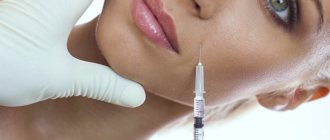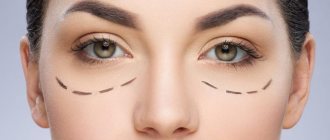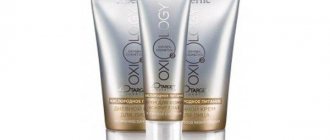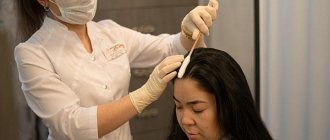After plastic surgery on the nose, patients complain of stuffiness. It occurs both after aesthetic (correction of defects) and after septoplasty (correction of the nasal septum). The nose begins to breathe differently in all patients. For some, on day 3-4, for others, by the end of the third week. Why this happens and what to do in case of prolonged recovery of breathing after rhinoplasty, we will tell you in this article.
Previously, after rhinoplasty, plastic surgeons inserted twisted sterile bandages - turundas - into the nasal passages. It was very painful to remove them from there, and I had to breathe through my mouth. Now the rehabilitation tactics have changed, and hollow silicone splints are used to maintain the shape of the nose. Their advantage is that air circulates through them. They are more elastic and durable, better retain the new shape of the nose and are not subject to mechanical deformation.
Rhinoplasty result before and after. Photo from the website of D.R. Grishkyan. There are contraindications, consultation with a specialist is required. Result of rhinoplasty Before and After. Photo from the website of D.R. Grishkyan. There are contraindications, specialist consultation is required
But despite this, nasal breathing may be difficult in the first week after surgery. There are natural reasons for this:
1. Internal swelling, which disappears after 7 days.
In our clinic, after rhinoplasty, a special splint is applied, and not a plaster cast, as in the old days. They leave no bruises or external swelling. Patients wear the splint for 7 days.
2. Formation of sap and drying of blood in the nose.
3. Dry mucous membranes.
Rhinoplasty result before and after. Photo from the website of D.R. Grishkyan. There are contraindications, consultation with a specialist is required. Result of rhinoplasty Before and After. Photo from the website of D.R. Grishkyan. There are contraindications, specialist consultation is required
When to see a doctor if breathing has not returned after rhinoplasty
After rhinoplasty, you must strictly follow the developed rehabilitation plan. In the first 3-4 days there will be difficulty breathing - this is the norm, so no measures need to be taken.
On the 7th day, when the splint is removed and the splints are removed. Many patients note that breathing becomes more free, but for 3 weeks they may still experience difficulty breathing. At this time, the doctor may prescribe medications that have anti-inflammatory and wound-healing properties.
After 3 weeks, swelling decreases by 80%. Therefore, in the period from 3 weeks to 3 months, patients may continue to complain of nasal congestion, absence or decreased sense of smell. By the end of the 3rd month, the sense of smell begins to recover. Complaints of difficulty breathing remain in 15% of patients.
https://www.instagram.com/p/CVfmlAZjDWg/
Contraindications
- Contraindications for septoplasty are similar to those for rhinoplasty.
- Blood clotting problems;
- Viral and infectious diseases of the acute phase;
- Oncological diseases;
- Serious pathologies of the cardiovascular system;
- Diabetes;
- Severe diseases of internal organs;
- Immune system diseases;
- Age up to 18 years;
- Pregnancy, lactation.
“The surgeon’s task is to always be in touch with the patient and support him during rehabilitation. Of course, even before the operation, I must talk about all the nuances of the recovery process, even if the patient himself is not very interested in this. Then, for example, the patient will not be afraid of swelling, which, as is known, increases during the first 4-5 days.”
Tamarov Alexey Nikolaevich plastic surgeon
Complications after rhinoplasty
Difficulty breathing, which may continue after the recovery period, may be caused by complications. The reasons for this may be:
1. Postoperative violations of the structure of the nasal septum. Some patients may develop a septal deformity. This happens in the event of a mistake on the part of the plastic surgeon, or in the case of a violation of the rehabilitation plan on the part of the patient.
2. Secondary hypertrophy of the mucous membranes. The reason for this is often the excessive use of vasoconstrictor drops.
Rhinoplasty result before and after. Photo from the website of D.R. Grishkyan. There are contraindications, consultation with a specialist is required. Result of rhinoplasty Before and After. Photo from the website of D.R. Grishkyan. There are contraindications, specialist consultation is required
All about septoplasty: indications, effectiveness, results
What you need to know about septoplasty?
If the patient had to face such a problematic diagnosis as a crooked nose, then the key procedure that can eliminate this defect can only be septoplasty. This is an effective surgical operation aimed at correcting the shape of the nasal septum. It is important to understand that this procedure does not involve a radical change in shape. Its goal is primarily health improvement, and the aesthetic aspect is brought into the background.
When is septoplasty necessary?
The nasal septum is a kind of plate consisting of two parts - cartilaginous and bone. It divides the nasal cavity into two parts. At first glance, it may seem quite logical that the nasal septum is almost flat, and, therefore, the two halves of the nasal cavity should be symmetrical. In fact, this is not entirely true, because the septum is distinguished by the presence of bends, so-called “outgrowths”, called “ridges” or “spikes” by doctors. According to doctors, the most common form of deformation is deviation to the left or to the right.
Causes of curvature may include:
- birth trauma (dislocation at birth);
- various types of disorders of the formation of the facial skeleton, especially during early childhood and adolescence;
- injuries;
- presence of neoplasms;
- violation of the anatomy of the nasal parts;
- the presence of foreign bodies in the nasal cavity.
For many years, such a diagnosis may not manifest itself. Even significant deformation does not cause severe symptoms. In such cases, further diagnosis may become somewhat more complicated, so if the slightest changes are detected, it is worth consulting with a specialist.
How does a deviated septum manifest and how dangerous is it?
Failure to consult a doctor in a timely manner can lead to unpleasant sensations that manifest themselves at the level of functioning of many vital systems. The list of symptoms is quite long.
Difficulty in nasal breathing
The degree of manifestation of this symptom can be radically different: from a moderate, almost imperceptible disturbance, to significant difficulties in breathing, up to its complete impossibility. Most often, such symptoms are caused by a unilateral curvature, which causes difficulty breathing in the corresponding half. It is important to determine whether the curvature is the only cause of the disease, and whether there are other factors that impede air flow. This symptom is most common in older people.
Chronic sinusitis
It occurs due to curvature of areas of the septum, which, in turn, cause insufficient ventilation of the paranasal sinuses. In simple words, conditions are created in the nasal cavity for the development of sinusitis, frontal sinusitis, sphenoiditis and other diseases, which often become chronic if the necessary measures are not taken in time.
Nosebleeds
The thinned mucosa is the area at the top of the spine that is most susceptible to injury. As a result, intense and sharp blowing of the nose can cause recurrent bleeding. It is also easy to provoke them even in the process of extracting dry mucus with your finger.
Hearing impairment
When air begins to flow poorly through the nasal cavity and nasopharynx to the respiratory tract, poor ventilation of the middle ear cavity may occur. Air does not reach the eardrum in sufficient quantities, which leads to the formation of tubootitis - an inflammatory process that develops in the auditory tube. It is highly not recommended to lead to such an outcome, since the disease is characterized by a sharp decline in hearing.
Pathologies of the pharynx and larynx
This kind of ailment is a consequence of one of the symptoms described above - impaired nasal breathing. Changes in the pharynx manifest themselves in chronic pharyngitis and tonsillitis, and among the common diseases of the larynx is chronic laryngitis. Poorly purified cold air enters the mucous membrane of the pharynx, larynx and tonsils, which provokes a chronic inflammatory process. To prevent the occurrence of such “traumatic” breathing, it is necessary to diagnose the root cause in time.
In addition to the listed symptoms, a deviated septum can cause frequent respiratory infections, accompanied by sinusitis and otitis media. Poor ventilation of the nasal cavity causes discomfort in the form of pain on the face and headaches. A nuisance such as snoring may also occur.
All these problems are indications for septoplasty. However, there are a number of limitations under which such surgical intervention is contraindicated. These include:
- poor blood clotting;
- diabetes;
- infectious diseases of various origins;
- oncological diseases;
- chronic diseases of the cardiovascular and respiratory systems during exacerbation;
- general unfavorable condition.
It is also worth noting that septoplasty also has some age restrictions. It is not recommended for patients who have not reached the age of majority. There is a completely logical explanation for this: bone and cartilage tissue are still not fully formed, and surgical intervention can aggravate the overall situation.
However, in some cases, surgery is the only treatment option. For example, when the inability to breathe fully affects the overall development of the child, both physically and mentally. The presence of significant indications is a sufficient reason to perform surgery from the age of 6 years. However, many otolaryngologists believe that surgical intervention can be practiced no earlier than 11 years of age.
Another age restriction for septoplasty concerns old age. During this period, difficulty breathing can cause considerable discomfort, but performing surgical interventions is also dangerous to health. In older patients, the risk of poor tolerance to anesthesia and, consequently, to the entire operation increases.
Types of septoplasty: which one to choose?
The nature of the curvature determines the choice of one or another treatment method. Today there are two of them:
- endoscopic;
- laser
Endoscopic septoplasty involves surgical manipulation by making small incisions in the nostril area. In this case, the soft tissues are peeled off, and the “extra” parts of the septum are removed. The septum itself is corrected by displacing cartilage or bone fragments. An endoscope is inserted into the nasal cavity - a tube with a diameter of up to 4 mm, which helps to monitor the progress of the operation to exclude possible injuries. In some cases, other interventions are provided. The operation ends with packing. Immediately after this, apply a cold compress.
Rehabilitation after endoscopic septoplasty involves the removal of tampons 2-3 days after surgery and a set of procedures regarding enhanced hygiene. It is necessary to remove the crust, as well as dried blood, by washing with a special liquid (this can be either sea water or saline). The doctor also prescribes ointment, spray or drops. To prevent infectious complications, you will need to take antibiotics.
During the rehabilitation period, it is necessary to avoid significant physical activity, and also not to visit the pool and sauna. In general, the occurrence of postoperative complications is very rare if you follow all the measures recommended by doctors.
Many people prefer laser septoplasty, in which the tissue is cut using a special safe laser. This technique has such advantages as bloodlessness, a minimum of rehabilitation measures and an antiseptic effect. The impact on tissue is minimal, and bleeding is stopped by cauterization.
But the patient does not always have the opportunity to choose, because the laser method, for example, is practically useless if it is necessary to manipulate bone tissue. Severe curvature can only be corrected using endoscopy. But it also does not carry any negative consequences in the form of scars, since modern medical technologies make it possible to do it quickly, painlessly and without visible traces of surgical intervention.
How to prepare for septoplasty?
First of all, you need to get professional advice from a doctor and be sure to tell him what medications you are currently taking. You may need to stop taking medications (for example, blood thinners). Women need to know that the operation can only be performed 7 days after the last menstrual period. Doctors include general recommendations that must be followed two weeks before septoplasty:
- quitting smoking and drinking alcoholic beverages;
- avoiding hypothermia;
- elimination of inflammatory foci that may interfere with surgical intervention;
- visiting the dentist;
- complete cure of infectious diseases.
Diagnosis of curvatures is carried out by inspection using special tools. In order to determine the degree of deformation as accurately as possible, an X-ray examination is often prescribed. In some cases, there may be a need for specialized examinations such as MRI, CT and video endoscopy (use of a camera to assess the condition of the mucosa). The list of tests that need to be taken includes an ECG, blood and urine tests, fluorography, coagulogram and others.
After discharge
Over the course of a month, the patient must visit an otolaryngologist who will monitor the progress of the rehabilitation period. In this case, it is necessary to independently take measures to prevent deformation. They do not exist as such, but every time a patient is going to take any medication, it is necessary to consult a doctor.
In many cases, it is possible to achieve not only anatomical, but also an aesthetic effect, although the second is not the primary goal of septoplasty. Today this is the most effective way to eliminate a deviated septum. The presence of two ways to carry out this procedure makes it possible to choose the one that can completely eliminate the flaw. As for prices, the endoscopic method is more affordable than the laser method, although the latter is in considerable demand.
When choosing one or another method of septoplasty, you can be sure that you are in good hands with the surgeons of our clinic. After the operation, you will finally take a deep breath and get that reflection in the mirror that you have long dreamed of! Take the first step towards your dream of a beautiful and neat nose - book a consultation with us by phone. Or write us a message via the feedback form - and we will definitely call you back and arrange an appointment.
Types of procedure
There are several options for septoplasty:
| Classical | Requires the use of a regular surgical scalpel. To prevent the cartilage from moving, a special mesh is placed on it, which dissolves over time. Sometimes the septum is removed and realigned and then put back in place. |
| Laser | It is carried out using a laser beam. The advantages of this technique are speed of operation, absence of bleeding and infectious complications, and accelerated rehabilitation. |
| Endoscopic | A special probe is inserted into the nasal cavity. All actions are filmed by a microscopic camera that displays the image on a monitor. The procedure requires the use of a scalpel, but is considered less traumatic than the classic method. |
| Ultrasonic | A modern type of operation using an ultrasonic knife. The technique allows you to quickly dissect the mucosa and seal the vessels without overheating the tissues. Ultrasound helps correct even the most severe deviated nasal septum. |
| Radio wave | The method combines the features of classical and laser septoplasty. The procedure eliminates the contact of the instrument with the organ, does not lead to injury or complications, and reliably seals the bone vessels. |
Correction of the nasal septum with a laser in Minsk is an effective and affordable option for surgery. Radio wave and ultrasound procedures are among the most expensive types of treatment.
Features of rehabilitation
Septoplasty in Minsk is carried out in accordance with all modern requirements. Patients who undergo the procedure can return home the same day. A short stay in the hospital is required when the procedure was performed under general anesthesia or in the presence of complications.
After the operation you must:
- for several days, rinse the tubes that are inserted into the nasal cavity to facilitate breathing;
- temporarily exclude physical activity, going to saunas, swimming pools, baths;
- refrain from natural or artificial tanning;
- sleep only on your back or side;
- follow a diet that includes avoiding hot, cold, spicy, and alcoholic drinks.
If the patient is bothered by pain, anesthetics are prescribed. To relieve severe inflammation or prevent its development, you may need to take antibiotics. To make breathing through the nose easier, drops are often used to relieve swelling.










